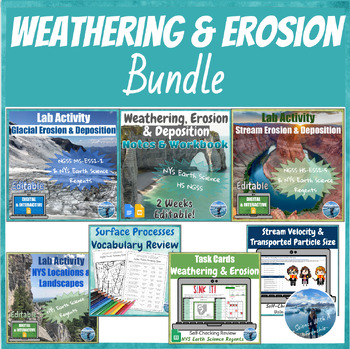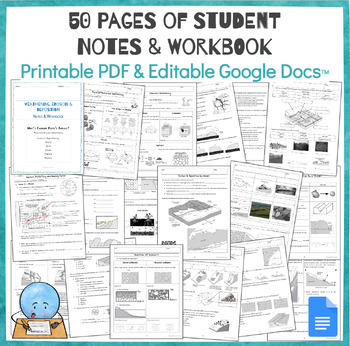Weathering, Erosion & Deposition Bundle | Notes, Lab & Review Activities | NYS
Science With A Frenchie
165 Followers
Grade Levels
8th - 11th
Subjects
Resource Type
Standards
CCSSRST.9-10.3
CCSSRST.9-10.4
CCSSRST.9-10.5
NGSSHS-ESS2-5
NGSSHS-ESS2-1
Formats Included
- Zip
- Google Apps™
Science With A Frenchie
165 Followers

Includes Google Apps™
This bundle contains one or more resources with Google apps (e.g. docs, slides, etc.).
Products in this Bundle (10)
showing 1-5 of 10 products
Description
This 3-week-long weathering, erosion & deposition bundle covers everything your students need to know about physical & chemical weathering, rates of weathering, soil formation, erosional & depositional features formed by gravity, wind, waves, glaciers & streams, landscape formation, and drainage patterns. It includes guided notes with practice questions, teacher presentations, 3 digital and interactive lab activities, 2 self-checking digital reviews, and a vocabulary review activity.
What's included?
- Notes & Workbook:
- Student Workbook: 40 pages of notes with practice questions to share with your students.
- Teacher Presentation: 225 Google Slides™ that go along the workbook.
- Teacher Notes: 5 pages of pacing guide with learning objectives and standards.
- Digital Lab Activity - Stream Erosion and Deposition
- In this Google Slides™ digital lab activity, the students will determine the ability of a stream to erode and deposit sediments depending on the water velocity. They will learn about erosional and depositional stream features such as V-shaped valleys, deltas, flood plains, and meanders as they take a virtual field trip and follow a river from the mountains to the ocean. This is an interactive lab activity with drag & drop features, videos, stream tables demos, and graphing.
- Digital Lab Activity - Glacial Erosion and Deposition
- In this Google Slides™ digital lab activity, the students will explore the effects of glaciers on landscapes. They will learn about the characteristic erosional and depositional landforms formed by glaciers such as striations on the bedrock, U-shaped valleys, drumlins, glacial erratics, finger lakes, moraines, kettle lakes, and outwash plains. This resource focuses on evidence of glacier erosion and deposition in New York State. This is an interactive lab activity with drag & drop features, videos, maps, and Regents questions. The key is included.
- Digital Lab Activity - NYS Landscape Regions
- In this Google Slides™ digital lab activity, the students will interpret New York State maps to see the influences of rock types over the landscape. They will also identify the different regions of NYS based on the changes in elevation throughout the state. This is an interactive Earth Science Reference Tables (ESRT) activity with drag & drop features. The key is included.
- Digital Review Activities: These Google Sheets™ self-checking & self-grading reviews are perfect to help students deepen their understanding in a fun and interactive way.
- Stream Velocity vs. Transported Sediment Size
- Task card review
- Surface Processes Vocabulary Review | Color by Number:
- The students will answer 10 questions and then they will color the corresponding parts of a fun science coloring page. The key terms covered in this Surface Processes color-by-number worksheet are abrasion, erosion, frost action, mass movement, physical weathering, chemical weathering, unsorted deposit, striations, meanders, and moraine.
Total Pages
Answer Key
Included
Teaching Duration
3 Weeks
Report this resource to TPT
Reported resources will be reviewed by our team. Report this resource to let us know if this resource violates TPT’s content guidelines.
Standards
to see state-specific standards (only available in the US).
CCSSRST.9-10.3
Follow precisely a complex multistep procedure when carrying out experiments, taking measurements, or performing technical tasks, attending to special cases or exceptions defined in the text.
CCSSRST.9-10.4
Determine the meaning of symbols, key terms, and other domain-specific words and phrases as they are used in a specific scientific or technical context relevant to grades 9–10 texts and topics.
CCSSRST.9-10.5
Analyze the structure of the relationships among concepts in a text, including relationships among key terms (e.g., force, friction, reaction force, energy).
NGSSHS-ESS2-5
Plan and conduct an investigation of the properties of water and its effects on Earth materials and surface processes. Emphasis is on mechanical and chemical investigations with water and a variety of solid materials to provide the evidence for connections between the hydrologic cycle and system interactions commonly known as the rock cycle. Examples of mechanical investigations include stream transportation and deposition using a stream table, erosion using variations in soil moisture content, or frost wedging by the expansion of water as it freezes. Examples of chemical investigations include chemical weathering and recrystallization (by testing the solubility of different materials) or melt generation (by examining how water lowers the melting temperature of most solids).
NGSSHS-ESS2-1
Develop a model to illustrate how Earth’s internal and surface processes operate at different spatial and temporal scales to form continental and ocean-floor features. Emphasis is on how the appearance of land features (such as mountains, valleys, and plateaus) and sea-floor features (such as trenches, ridges, and seamounts) are a result of both constructive forces (such as volcanism, tectonic uplift, and orogeny) and destructive mechanisms (such as weathering, mass wasting, and coastal erosion). Assessment does not include memorization of the details of the formation of specific geographic features of Earth’s surface.





